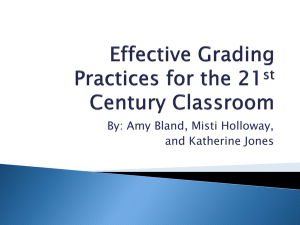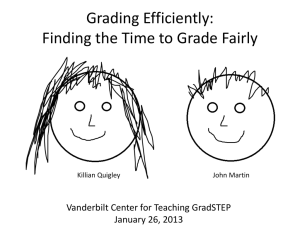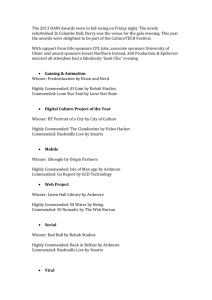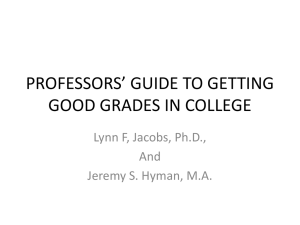Dealing with the 15% Grading Requirement for STAAR EOC
advertisement
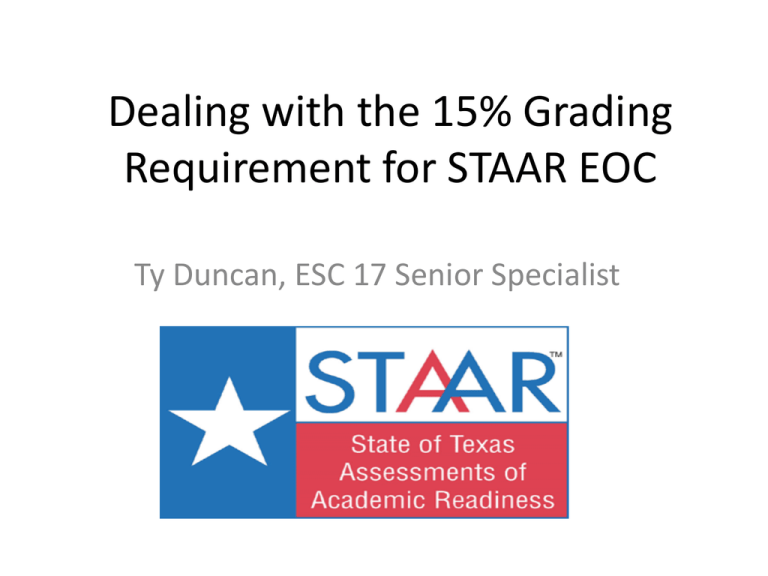
Dealing with the 15% Grading Requirement for STAAR EOC Ty Duncan, ESC 17 Senior Specialist The Law: Whether We Like it or Not • “A school district shall comply with the State Board of Education rules regarding administration of the assessment instruments listed in this subsection and shall adopt a policy that requires a student’s performance on an end-of-course assessment instrument for a course listed in this subsection in which the student is enrolled to account for 15 percent of the student’s final grade for the course.” H.R. H.B. No. 3, 81 (R) Cong., Texas Legislature Online Version: Enrolled, 46-47 (201). • http://www.legis.state.tx.us/BillLookup/Text.aspx?LegS ess=81R&Bill=HB3 Accessed online, March 8, 2011 What does “Final Grade” Mean • There seems to be a lot of disagreement over what this means in all directions. • Does it mean second semester only? • Must we count first and second semester together? • Will we be holding to the letter of the law if we choose second semester only? Policy Decisions • Focus groups initially made two vital decisions which districts need to make after study and discussion. These include: – a) how a percent score is calculated from the individual student report on an EOC exam, and – b) how that score will be applied to meet the 15% requirement. Additionally, focus groups determined that there are three over-arching issues that need to be specified in policy. These include how the EOC will impact grades/GPA, class rank, and credit. Issues related to Computing a Score: • It is not practical to compute a percentage score from the raw score only, because the passing standard will not necessarily be set at 70% of items correct. • Focus group participants were relatively unanimous that the process requires use of the scale score. Therefore, the question becomes how to turn a scale score into an averageable grade. • A few districts are considering an arbitrary assignment of a percentage score to four identifiable scale point ranges. These include an arbitrary assignment of a score to anyone who fails, another score to anyone between passing and commended, another score for anyone commended or above with 100% being applied for anyone who gets all items correct. There was some support for differentiating a grade that falls between minimum and passing and for the scale score that meets the College-Readiness standard in Algebra II and English III. Standardize Grading Practice? • This issue has the potential to bring to light toxic grading practices in our schools. For the most part grading is an individual teachers decision from classroom to classroom. • Marzano speaks of this issue in his book “Standards Based Grading and Formative Assessment.” The only thing we can currently tell about grades in public schools is by taking a look at each individual teacher. • The 15% issue is going to standardize grading on some level for us and monitoring effective practice will be very important. 15% and UIL • Additionally, a district should determine a local policy related to whether retest scores will be counted toward changing a student’s semester or course grade. This practice should be considered in light of UIL policies. UIL produces a side-by-side document with state law and corresponding UIL rules. • It is anticipated that if the 15% requirements remain in law, UIL will likely amend this document. Watch for those changes and how they relate to your local policy decisions. Retesting for Any Reason • In my opinion the FIRST ADMINISTRATION ONLY should count for the grading requirement. It is going to be a mess to go back and recalculate grades in the summer after retest. It also will decrease the high end student retesting to get a higher score to improve their class rank. • This may be something you want to deal with, but please remember the amount or retesting under STAAR is going to be huge and with staffing cuts monitoring this and planning the sessions is going to place an additional burden on test coordinators. • Retesting for any reason can be used to obtain course credit should the assessment cause them to fail the course. This raises a question with consistency. Computing a Score • It is not practical to compute a percentage score from the raw score only, because the passing standard will not necessarily be set at 70% of items correct. Focus group participants were relatively unanimous that the process requires use of the scale score. Therefore, the question becomes how to turn a scale score into an average able grade. • A few districts are considering an arbitrary assignment of a percentage score to four identifiable scale point ranges. These include an arbitrary assignment of a score to anyone who fails, another score to anyone between passing and commended, another score for anyone commended or above with 100% being applied for anyone who gets all items correct. • There was some support for differentiating a grade that falls between minimum and passing and for the scale score that meets the College-Readiness standard in Algebra II and English III Example • • • • • Below passing scale score: 65% Within passing to commended range: 75% Commended to 100%: 90% 100% = 100% Others are considering sliding this scale upward. ** Not entirely equitable or sophisticated. Dr. Wallace Model Dr. Wallace Model • I like this model because it gives hope at the bottom end of the scale. It will have to be adapted by districts as the scale scores will change for STAAR, but the model is a good one and is fair as we enter a system that we have not seen. • I certainly would not publish the corresponding raw score or make it part of policy. • Calculate the distribution of grades after the assessment. • You will need to write policy that states how your are going to calculate the grade using the scale score in a psychometric way should you choose to do this. Dr. Wallace Model Impact of 15% Is Up to You!! Little Impact Big Impact Grading Policy • Make sure that your decision on how to implement is consistent with grading policy that is currently in place. • Most policies will take slight adjustment. Considerations • A “Guaranteed and Viable Curriculum” will help with this issue. • Grade inflation may be a fairly substantial problem in the beginning. • We will have two grading systems in place most likely. One for 9th graders and one for 10th-12th graders next year. The two systems will be phased out with TAKS. Using the EOC as the Final Exam • Several districts have moved in this direction. • The question then is what to do the two weeks after STAAR? – My response is that they still have content left to teach and the six weeks grade will still be impacted by the learning during this time. • The most controversial issue has been with those who have an exemption policy and allow students to not take finals based on attendance. Resources • “Fair Is Not Always Equal”—Rick Wormeli – http://www.youtube.com/watch?v=TM-3PFfIfvI – http://www.youtube.com/watch?v=NC7ZI8zr_Mk – http://www.youtube.com/watch?v=FHeij2Zfil4 • Robert Marzano – http://www.youtube.com/watch?v=mfOnyrWtPu0 • Dr. Lisa Leach and I conducted a few weeks ago on our website. – http://www.esc17.net/default.aspx?name=dcl.instruc tionalleaders


